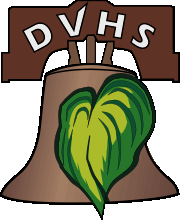
Click on a header for main topic, or hover and click on one of the drop-down topics.
Sign in and participate!

DELAWARE VALLEY
HOSTA SOCIETY
Our next meeting is on February 1st, 2025.
More activities posted on our calendar!
Celebrating hostas since 1982!
The genus Hosta comprises perhaps three dozen species, but natural mutations (“sports”) and hybridization has resulted in thousands of cultivars. (The American Hosta Society now records over 6000 named and registered cultivars!) Some cultivars are true miniatures, with leaves the size of a fingernail, while others are giants with leaves well over a foot long. While the flowers are not generally the most appealing feature of a hosta, some are quite beautiful and a special subset are delightfully fragrant.
Below are some general descriptions of hostas and their uses, along with links to our pages on growing hostas and a special “What hosta do I have?” feature for anyone who might have “inherited” some unknown hostas. A must-know website for anyone interested in hostas is The Hosta Library, containing submitted pictures of several thousand hostas, both popular and obscure. A great 1-page (webpage) summary on Hosta Diseases and Culture is at Hallson Gardens. For links to even more information about hostas, see our Links page.
About hostas: A brief owner's manual

Colors, shapes and sizes
Hosta leaves come in four main colors: blue, green, yellow, and white. Color combinations are also important. The leaves can have different shapes as well as margin colors different from the center color. The leaves can have wide irregular margins or very distinct but thin margins. The spring color also may not be stable all season long. The leaf surface can be flat, curled, cupped, wavy, contorted, piecrust, or furrowed. Flat surfaces have even and smooth features. A rugose leaf has uneven features such as dimpled, puckered, embossed, ruffled, pleated, wrinkled, and crinkled leaf surfaces. Cupped leaf surfaces are cupped around the margins. Wavy leaves are relatively smooth but wave or undulate along the margins. Contorted leaves are warped, or distorted. Piecrust leaves have closely spaced, distinct, regular, undulations along the margins. Furrowed leaves show the veins sunken or impressed, creating a ribbed effect.
Hosta flowers
Hostas can bloom anytime from June to October and the flowers can be funnel-, bell-, or even spider-shaped. They range from white to deep purple, with some showing purple and white stripes. Some, based on hybrids of the August Lily H. plantaginea, are fragrant. Like their distant relatives in Hemerocallis (daylily), each flower is open for only one day, but with many flowers on a stalk and many stalks arising from a mature clump, the floral effect can be quite impressive.
Uses for hostas
-
Border/Edger planting: for the border are generally 12 inches or less in height but have increased horizontal growth. By overhanging a lawn edge they are able to control weeds as they leave no room or light for them.
-
Background planting: Large green hostas will show off more colorful varieties of plants. Hostas that emerge with tremendous color but fade to all green and are great background plants.
-
Specimen planting: Eye-catching hostas can be allowed to grow into very large clumps.
-
Ground cover planting: Hostas that are fast growers and form a thick mat of roots and plants will cover the ground and prevent weed growth.They can be a natural brightener for shady or dark gardens if you use yellow and/or white-variegated hostas.
-
Container planting: Many hostas (particularly the smallest ones) do well in containers if protected from winter freeze/thaw cycles.


